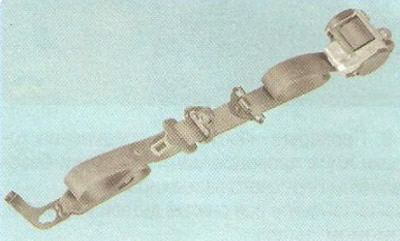Warnings: Airbags do not replace seat belts. Moreover, when the car is moving, the driver and front passenger must be sure to wear their seat belts, since in the event of a traffic accident, a deployed airbag itself can cause serious injury to a person who is not wearing a seat belt.
In addition, passengers in the back seat must be fastened with seat belts. In the event of an accident, an unbelted passenger in the rear seat can cause injury and serious injury to all passengers in the vehicle.
The SRS system includes the following elements:

- a driver airbag module located in the steering wheel hub pad and consisting of a folded airbag shell, a gas generator;

- front passenger airbag module installed in the instrument panel on the passenger side and consisting of a folded airbag shell and a tubular inflator. Differs from the driver's airbag in shape and large volume;

Note: This is what the front passenger airbag module looks like removed from the vehicle.

- The side airbag system consists of airbags installed in the backrests of the front seats. The places where the pillows are installed are inscribed «AIRBAG»;

- electronic control unit (ECU), mounted on the floor tunnel under the center console.
Sensors built into the ECU (accelerometers), which measure the longitudinal and lateral acceleration of the car in a collision. The ECU evaluates the impact force by comparing the values it receives from the front impact sensor, side impact sensors, and internal electronic sensors with a predetermined value. If the deceleration signal due to a frontal or side impact exceeds a predetermined value, the ECU will trigger the seat belt pretensioners and deploy the corresponding airbags.
If the vehicle's battery is damaged during the crash, the voltage holding circuit in the ECU will still be able to activate the airbags for some time after the crash;

- front seat belt pretensioners (mounted in the inertial coils of the front belts) with tension limiters.
Pretensioners provide a timely response to an emergency deceleration of the car, pulling the driver and passengers to the seat backs, exclude their further movement forward by inertia and injury from the deployed airbag;
Note: The seat belt pretensioner mechanism always deploys before the airbag.
- headrests mounted on the backs of the driver's and front passenger's seats of cars of all trim levels and on the back of the rear seat. The head restraints prevent damage to the cervical vertebrae of occupants in the event of a severe rear impact or airbag deployment.
The front and rear seat head restraints can be adjusted in height by pressing the lock and moving the head restraint up or down to the desired height (see «Front seat adjustment»);
Note: The best position for the head restraint is when its upper edge is flush with the top of the head.
For very tall people, raise the head restraint to its highest position, for very short people, lower the head restraint to its lowest position.
- airbag warning light (see «instrument cluster»). If the ECU detects a malfunction in the system, the warning light comes on.
Warning: If the lamp lights up, contact a car service immediately. In addition to possible failure in an emergency, the airbag may deploy unexpectedly while driving, resulting in serious consequences.
